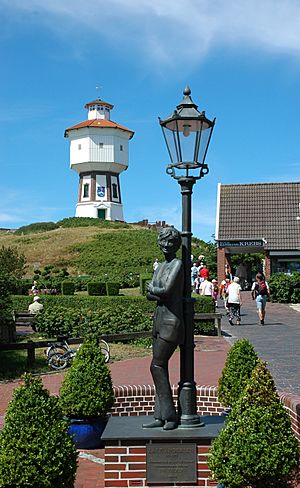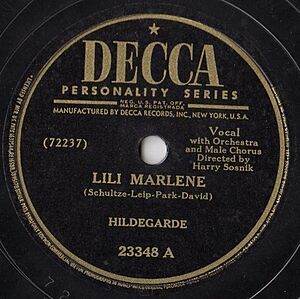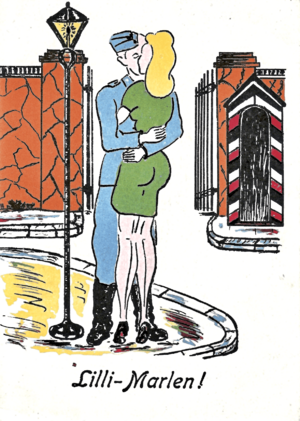Lili Marleen facts for kids

"Lili Marleen" is a very famous German love song that became popular during World War II. It was sung by soldiers from both the Axis and Allied sides across Europe and the Mediterranean. The song was first written as a poem in 1915. It was published in 1937 and first recorded in 1939 by Lale Andersen. The song also became very well known through a version sung by Marlene Dietrich.
In 2005, a special collection of 7 CDs was released called Lili Marleen an allen Fronten ("Lili Marleen on all Fronts"). It included almost 200 different versions of the song!
Contents
How the Song Was Made
The words for "Lili Marleen" were written in 1915 by Hans Leip (1893–1983). He was a school teacher from Hamburg, Germany, who had joined the army. Leip reportedly got the idea for the name by combining "Lili," the nickname of his friend's girlfriend, with "Marleen," the name of a nurse he knew. The poem was later published in 1937.
The music for the poem was created by Norbert Schultze in 1938. Lale Andersen was the first person to record the song in 1939. In 1942, she even recorded an English version.
Other songwriters also created English lyrics for the song. Tommie Connor wrote a version called "Lily of the Lamplight" in 1944.
Marlene Dietrich's Famous Version
Quick facts for kids "Lili Marlene" |
||||
|---|---|---|---|---|
 |
||||
| Single by Marlene Dietrich | ||||
| B-side | "Symphonie" | |||
| Released | 7 September 1945 | |||
| Recorded | 1944 | |||
| Genre | ||||
| Length | 4:45 | |||
| Label |
|
|||
| Songwriter(s) |
|
|||
| Marlene Dietrich singles chronology | ||||
|
||||
During World War II, a special group in the U.S. called the Office of Strategic Services (OSS) started a project to broadcast music. This music was meant to make enemy soldiers feel less confident. Marlene Dietrich, a famous singer, recorded several songs in German for this project, including "Lili Marleen." She also performed the song live for Allied troops in Europe, often on simple stages.
"Lili Marleen" became the main song for the OSS's German radio station, Soldatensender. Because the soldiers loved it so much, Dietrich re-recorded the song. This new version was released by Decca Records in 1945.
In 1961, Dietrich acted in a movie called Judgment at Nuremberg. In one scene, she walks through a damaged street and hears men singing "Lili Marleen" in German. She starts singing along and tells the other character that the German lyrics are "much sadder" than the English ones.
From 1953 to 1975, Marlene Dietrich performed in live shows around the world. "Lili Marleen" was almost always part of her performance. She would often introduce it by saying how special the song was to her. She explained that she sang it for three long years during the war, for soldiers in many different places.
Dietrich also sang "Lili Marleen" in her TV special An Evening with Marlene Dietrich in 1973. She recorded and performed the song in both German and English.
Track Listings (Main Versions)
English Version
- Side A: "Lili Marlene" (Written by Norbert Schultze, Hans Leip, Mack David) – 3:24
- Side B: "Symphonie" (Sung in French) – 2:55
German Version
- Side A: "Lili Marlene" (Sung in German) (Written by Norbert Schultze, Hans Leip) – 2:56
- Side B: "Du, Du Liegst Mir Im Herzen" (Traditional) – 2:02
Connie Francis's Version
| "Lili Marleen" | ||||
|---|---|---|---|---|
| Single by Connie Francis | ||||
| B-side | "Mond von Mexico" | |||
| Released | 1962 | |||
| Recorded |
|
|||
| Genre | Schlager music | |||
| Length | 1:55 | |||
| Label | MGM Records (61 053) | |||
| Songwriter(s) | ||||
| Producer(s) | Gerhard Mendelsohn | |||
| Connie Francis German singles chronology |
||||
|
||||
American singer Connie Francis recorded "Lili Marlene" on June 3, 1961. She also recorded the song in Italian and French. Her version of "Lili Marleen" became popular in Germany, reaching number 9 on the German music charts in 1962.
Track Listing
- Side A: "Lili Marlene" (Written by Norbert Schultze, Hans Leip) – 1:55
- Side B: "Mond von Mexico" (Written by Fini Busch, Werner Scharfenberger)
Chart Performance
| Chart (1962) | Peak position |
|---|---|
| Germany | 9 |
Amanda Lear's Version
| "Lili Marleen" | ||||
|---|---|---|---|---|
| Single by Amanda Lear | ||||
| from the album Never Trust a Pretty Face | ||||
| B-side | "Pretty Boys", "Dreamer (South Pacific)" | |||
| Released | 1978 | |||
| Recorded | 1978 | |||
| Genre | Euro disco | |||
| Length | 4:45 | |||
| Label | Ariola Records | |||
| Songwriter(s) |
|
|||
| Producer(s) | Anthony Monn | |||
| Amanda Lear singles chronology | ||||
|
||||
French singer Amanda Lear recorded a Euro disco version of "Lili Marleen" in 1978. It was released as part of her album Never Trust a Pretty Face. She also performed the song in an Italian film in 1978.
Lear recorded the song again for later albums, with some updated lyrics.
Track Listing (7-inch single)
- "Lili Marleen" – 4:45
- "Pretty Boys" – 2:55
Chart Performance
| Chart (1979) | Peak position |
|---|---|
| Italy (Musica e dischi) | 11 |
| France (IFOP) | 34 |
Other Famous Versions
Many other artists have recorded "Lili Marleen" over the years. The Italian version, sung by Lina Termini in 1942, was one of the first to be released. Anne Shelton likely made the earliest English recording.
During WWII, Allied troops in Italy sang a version called "The D-Day Dodgers". Perry Como recorded the song in 1944, and it reached number 13 on the United States charts. Other famous singers like Bing Crosby, Vera Lynn, and Connie Francis also recorded their own versions.
The song has even been adopted as a special march for military groups like the Special Air Service in the UK and Australia.


